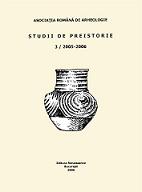Date privind unele descoperiri funerare de la Măriuţa-La Movilă
Data about some funerary discoveries from Măriuţa-La Movilă
Author(s): Valentin Parnic, Cătălin LazărSubject(s): Archaeology
Published by: Editura Cetatea de Scaun
Keywords: Eneolithic; Kodjadermen-Gumelniţa-Karanovo VI complex; cemetery; burials
Summary/Abstract: The eneolithic tell Măriuţa-La Movilă is situated at 200 m north-west by Măriuţa village in the Călăraşi County. This is a settlement from second half of the fifth millennium (Kodjadermen-Gumelniţa-Karanovo VI complex). The first research of the tell was started in the period 1984-1990 by Mihai Şimon. In the year 2000 the excavations were resumed by The Lower Danube Museum Călăraşi. In the year 2004 new excavations were started on the terrace, near the tell. The goal of this new excavations, was to detect the cemetery of the tell. It was very complex and complicated, because at this moment we don’t have a concrete method for identification of cemeteries. The only dates we have are from Bulgaria, where we have some examples of cemeteries. Eleven extramural eneolithic (Vinica, Goljamo Delčevo, Durankulak, Devnja, Varna I, Tărgovište, Liljak, Radingrad, Omurtag, Demir Baba Teke - Sboryanovo, Pomoštica) and three intramural (Kubrat, Ruse, Junacite) cemeteries on the territory of Bulgaria have been partially or completely studied. In Romania are known just ten extramural cemeteries (Vărăşti-Grădiştea Ulmilor, Gumelniţa, Gumelniţa-Valea Mare, Chirnogi-Terasa Rudarilor, Cetatea Veche-Grădiştea, Chirnogi-Şuviţa Iorgulescu, Căscioarele-D’aia Parte, Radovanu, Dridu, Sultana-Malu Roşu) belonging to this culture. As it would now appear, the location of extramural cemeteries was generally established within a range of 300 m of the settlement, on the high places (especially terraces), non-floodable. In most cases the cemetery was situated to the west (Goljamo Delčevo, Radingrad, Demir Baba Teke - Sboryanovo, Tărgovište, Radovanu, Sultana-Malu Roşu etc.), north-west (Pomoštica, Căscioarele-D’aia Parte, Vărăşti-Grădiştea Ulmilor), south-west (Durankulak), south-east (Vinica) or east (Gumelniţa) of the settlement. Pointing out these examples we started our research on the high terrace of Mostiştea River near the settlement. The terrace is at 100 m north-east range of the tell. The area of terrace was divided in a grid of twenty-one 20 x 20 m units for a better management of the excavation. Excavation methodology consist in sondages of different dimensions (3 x 1 m, 9 x 1 m or 8 x 2 m) situated at 10-15 m range one of the other, in order to cover a wider surface. During the period 2004-2006 we accomplish 22 sondages, and we researched a surface of 134 m2 of the terrace. In this sondages we found five inhumations graves. Four of this graves (M1, M3, M4, M5) are from Kodjadermen-Gumelniţa-Karanovo VI period and last one (M2) is a sarmatic burial. The eneolithic graves contain skeletal in contracted position on left side (M3, M4, M5) and on right side (M1). The legs were moderately or strongly flexed. Orientation was ESE 109° – VNV 239° (M1), E 99°– V 279° (M3), ENE 65°– VSV 245°(M4) and E 95°– V 275° (M5). Funerary gifts were found in just two graves: M4 – a stone chisel, a cooper tool and a flint blade; M5 – a fragmentary flint blade. In
Journal: Studii de Preistorie
- Issue Year: 2007
- Issue No: 4
- Page Range: 135-157
- Page Count: 22
- Language: Romanian

